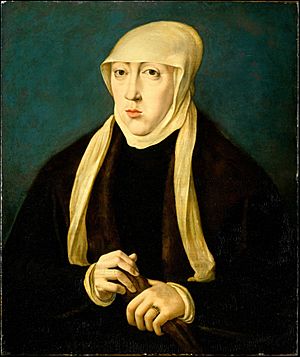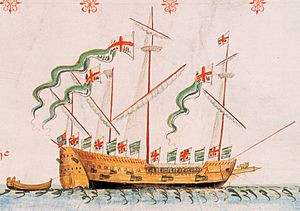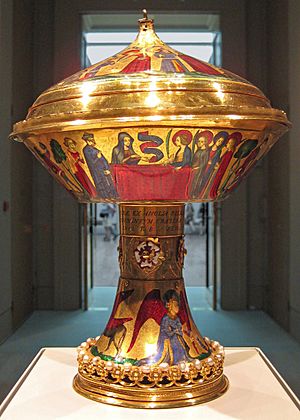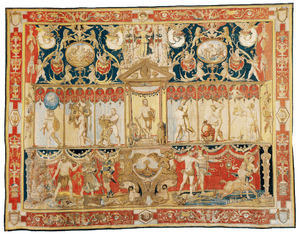Inventory of Henry VIII facts for kids
The Inventory of Henry VIII was a huge list made in 1547 of everything the King owned when he died. It's like a giant treasure map showing all his royal stuff! This amazing list is now kept safe at the British Library.
The inventory was put together in 1547, right after King Henry VIII passed away and his son, Edward VI of England, became king. The people making the list went through all of Henry's houses, noting down every single item. They even listed the weapons on his ships and in his forts. In total, there were 17,810 entries, and some of these entries included many objects. Even with so many items listed, only a tiny number of them still exist today. The list didn't say how much things were worth, but it did record the weight of many gold and silver items.
Contents
The King's Amazing Collections
The inventory was meant to list all of Henry VIII's jewels, gold and silver items, household goods, weapons, and military supplies. Special teams were sent to check all the royal homes, stables, and weapon storage areas. Let's explore some of the cool things Henry owned!
Gold, Silver, and Jewels
The inventory has almost 3,700 entries just for precious metals and jewels! These included a special box of jewels belonging to Catherine Parr, Henry's last wife. Inside were fancy gold headpieces with pearls and diamonds, and belts with gold links, diamonds, rubies, and pearls. There were even two jewels with the letters HK for Henry and Katherine.
One very special item was a jewel called the Three Brothers. It was a pendant with three big red jewels (called balas rubies), diamonds, and pearls. Henry bought it from a rich merchant named Anton Fugger. King Edward VI, Henry's son, had to buy this jewel for a huge amount of money because the English crown owed a lot to the Fugger bank.
The beautiful Royal Gold Cup, which you can see in the British Museum today, was also on the list. It was described as "a Cuppe of gold with Imagerie," meaning it had pictures on it. It was decorated with 62 pearls. Sadly, some parts of the cup and its pearls were lost over the years. The inventory also recorded gifts given to diplomats and even some accidents. For example, in 1552, young King Edward VI lost a large pearl from a gold chain while riding. Luckily, it was found and returned!
Palaces and Houses
Henry VIII had 55 different palaces and houses! The inventory listed items not just in his main palaces, but also in the homes and wardrobes of his children. Some of these included:
- Manor of Beddington in Surrey
- Durham Place in London (Prince Edward's former home)
- Manor of Nonsuche in Surrey
- Hampton Court in London
- New Hall in Essex (Lady Mary's usual home)
- Manor of Richmond in Surrey
- Sudeley Castle in Gloucestershire (where Catherine Parr's belongings were kept)
These houses were filled with amazing textiles and beds. The inventory also showed Henry VIII's personal interests. At Westminster Palace, he had a small study called the New Library. It was equipped for writing, drawing, painting, and even surveying land. He had shelves with models for castles and war machines, and a special case for plans, described as 'a case for a platte covered with leather.'
Tapestries and Textiles
Henry VIII loved tapestries! A historian once said he had "a perfect mania for acquiring tapestries." The 1547 inventory listed about 2,450 tapestry wall hangings and 300 other tapestry furnishings. These were huge, often covering entire walls, and showed stories or beautiful scenes.
One new set of tapestries in the Westminster Wardrobe showed the story of Vulcan, Mars, and Venus. They were made of fine tapestry and lined with canvas.
Among the many other fancy textiles, there was a crimson bed and cushions at Hampton Court. These were embroidered with the coat of arms of James V of Scotland. These items might have been taken from Edinburgh in 1544 during a conflict.
The inventory also listed a zibellino, which was a sable fur accessory with a gold head and muzzle. It was decorated with emeralds, turquoises, and rubies, and had a ruby tongue and gold feet. This special item had belonged to one of Henry's queens and was later given to Lady Jane Grey.
Furniture and Furnishings

Henry VIII had a collection of portraits, including two of the legendary King Arthur and one of Mary of Hungary, who was the ruler of Flanders. He also owned a painting of James IV of Scotland.
In his later years, Henry VIII became unwell and was carried around his palaces in special chairs called "trauewes." These chairs had a step and were upholstered in different colored velvets, like tawny, russet, and purple. The backs of the chairs were decorated with an embroidered rose using gold thread.
Royal Parties and Costumes (Revels)
The inventory also listed all the items used for royal parties and entertainment, managed by the Master of Revels, Thomas Cawarden. This included costumes for court plays (Masques) for both men and women, and fancy decorations for horses. Cawarden was also in charge of the royal tents.
The theatrical props included:
- Two coverings of gold cloth and purple velvet, embroidered with a silver knight riding a mountain and a lady throwing darts at him.
- Many long, narrow costumes for men, made of gold and silver cloth, with green satin stripes.
- Eight Italian gowns for women with ruffled sleeves, some striped with silver and gold.
Cawarden's collection of tents included large ones for the King's lodgings and dining areas, decorated with rich painted and embroidered hangings. Some of these tents were even used by the Earl of Warwick during a military campaign in Scotland in 1547. They came back "wetted in the shippe," so Cawarden had to pay extra to dry them!
Musical Instruments
Most of Henry VIII's musical instruments were kept at Westminster Palace. Some of the larger instruments were beautifully decorated. Henry himself was a musician and could play several instruments, including the lute, harp, flute, and horn.
The inventory listed many types of instruments, such as:
- Bagpipes: Some made of purple velvet with ivory pipes.
- Clavichords: Two, one covered in gilt leather.
- Crumhorns: Cases of them, including ivory ones.
- Flutes: Many flutes, including some made of ivory tipped with gold, and even glass flutes!
- Harpsichords and Virginals: Many different types, including new ones made of cypress wood with ivory keys.
- Lutes: 23 lutes with cases.
- Organs: Three, including one in the Chapel of St James's Palace.
- Portative organs: Small, portable organs covered in crimson satin.
- Recorders: Many recorders made of wood, walnut, ivory, and box-wood.
- Regals: Small organs, some decorated with the King's and Jane Seymour's coats of arms.
- Viols: 19 great and small viols, and Spanish viols.
Ships

The inventory also listed Henry's ships, both those at sea and those docked. It included details about their weapons and crews. Two ships on the list, The Sallomander and The marie willowby, had been captured from the Royal Scots Navy in 1544.
Some of the ships listed were:
- The Antlopp
- The Henry Grace a dewe (Henry's famous flagship)
- The Petir
Forts and Armouries
The inventory also recorded the guns in English coastal forts and even in forts in France. It listed body armor from the Hampton Court armoury for military trips to Scotland. It also noted iron cannonballs for captured Scottish guns stored in Calais.
The lists detailed cannon, hand-held weapons, gunpowder, and shot. Some cannons were old, dangerous, or broken. The inventory even mentioned broken firing parts for certain guns. Many garrisons (military bases) had Moorish pikes, bills (a type of polearm), and bows.
Here are some of the important places where royal weapons were stored:
London Armouries
- Greenwich Armoury: Had 100 Italian handguns.
- Greenwich Tiltyard: This was a place for jousting and training. It had special armors for the King, including one given to him by the Emperor Maximilian. It also had equipment for young Edward VI's practice, like wooden horses and fancy saddles.
- Hampton Court: Stored many types of armor, including 200 pairs of light German armor (Almain rivets). Many of these were sent to the Earl of Warwick for use in Scotland or to Wales.
- Tower of London: This was a major storage for weapons. It had many types of guns, including brass cannons, French brass guns, and even Scottish brass guns captured in battle. It also stored thousands of bows, arrows, bills, halberds, javelins, and pikes. Some very unusual items were also here, like "holy water sprinklers" that had guns hidden inside!
Forts in England
Many castles and forts along the English coast were listed, showing their cannons, guns, and other weapons. For example:
- Pendennis Castle in Cornwall had brass and iron cannons, and many bows and pikes.
- Portland Castle in Dorset had brass cannons and various iron guns.
- Deal Castle in Kent had brass cannons, iron bases, and many hagbuts (early firearms).
- Dover Castle in Kent had demi-culverins and sakers, along with chainmail coats and armored jackets.
- Carlisle Citadel and Carlisle Castle in Westmorland had brass sakers and falcons, along with many bills and pikes.
- Kingston-upon-Hull in Yorkshire had a castle and two blockhouses, all equipped with various cannons and weapons.
Forts in France
Henry VIII also had forts in France, especially around Calais, which was English territory at the time.
- Calais: This was a huge military hub. The Ordnance House stored thousands of cannonballs, many of which were for guns that were no longer used! It also had a "Wildfire House" for making and storing fire-based weapons. The Armoury had helmets, cuirasses (chest armor), and gauntlets. The Longbow chamber had 1500 longbows.
- Boulogne: This city had recently been captured by Henry. Its forts were filled with cannons, mortars, and hagbuts, though many of their wheels and stocks were rotten.
- Newhaven (Ambleteuse): A star-shaped fort with many cannons and fowlers (a type of cannon).
Forts in Scotland
During the "Rough Wooing" (a war between England and Scotland), Henry VIII's forces captured several Scottish castles and forts, and their armaments were also listed.
- Broughty Castle in Fife: Had 100 hand-guns, bows, and hagbuts.
- Eyemouth in Berwickshire: Had brass sakers, falcons, and iron fowlers.
- Hume Castle in Berwickshire: Had demi-culverins, falconets, and many hagbuts.
- Inchcolm Island in the Firth of Forth: Had culverins, sakers, falcons, and many arquebuses (another type of early firearm).



